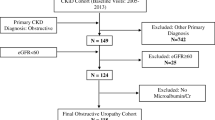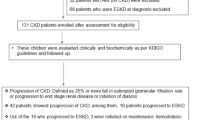Abstract.
The purpose of this study was to identify clinical, nutritional, and laboratory factors associated with the rate of progression of chronic renal insufficiency among children and adolescents admitted to a pre-end-stage renal failure (ESRF) interdisciplinary program. Sixty-two children and adolescents aged 2 months to 19 years with chronic renal failure on conservative management were prospectively followed from 1990 to 1999. The following variables were analyzed: age at admission, sex, race, blood pressure, primary renal disease, Z scores for weight and height, glomerular filtration rate (GFR), urea, and presence and degree of proteinuria. Progression to ESRF was assigned as a dependent variable. The analysis was conducted in two steps. In a univariate analysis, variables associated with ESRF outcome were identified by the log-rank test. Then, the variables that were significantly associated with adverse outcome were included in a multivariate analysis. This analysis, using the Cox proportional hazards model, was performed to identify variables that were independently associated with a worse prognosis. Only variables that remained independently associated with adverse outcome were included in the final model. Twenty-one (34%) patients evolved to ESRF during a median follow-up of 43 months. Two variables were identified as independent predictors of progression to ESRF: GFR under 30 ml/min (RR=3, 95% CI=1.7–5.3, P=0.0001) and severe proteinuria (RR=3.1, 95% CI=1.2–7.6, P=0.01). The combination of two factors—GFR lower than 30 ml/min and presence of severe proteinuria on admission—was an independent indicator of adverse outcome in children and adolescents with chronic renal insufficiency who were conservatively managed.




Similar content being viewed by others
References
Klahr S, Schreiner G, Ichikawa I (1988) The progression of renal disease. N Engl J Med 318:1657–1666
Brenner BM, Meyer TW, Hostetter TH (1982) Dietary protein intake and the progressive nature of kidney disease: the role of hemodynamically mediated glomerular injury in the pathogenesis of progressive glomerular sclerosis in aging, renal ablation, and intrinsic renal disease. N Engl J Med 307:652–659
Mackenzie HS, Brenner BM (1998) Current strategies for retrading progression of renal diseases. Am J Kidney Dis 31:161–170
Locatelli F, Del Vecchio L, Andrulli S, Marai P, Tentori F (2000) The role of underlying nephropathy in the progression of renal disease. Kidney Int 57 [Suppl] 75:49–55
Moore E, Aronson A, Northrup T (1986) The assessment of renal function. In: Postlethwaite RJ (ed) Clinical pediatric nephrology, 1st edn. Wright, Bristol, pp 404–411
Schwartz GJ, Haycock GB, Edelmann CM Jr, Spitzer A (1976) A simple estimate of glomerular filtration rate in children derived from body length and plasma creatinine. Pediatrics 58:259–263
Kaplan EL, Meier P (1958) Nonparametric estimation from incomplete observation. J Am Stat Assoc 53:457–481
Cox DR (1972) Regression models and life-tables. J R Stat Soc B 34:184–220
Mickey RM, Greenland S (1989) The impact of confounder selection criteria on effect estimation. Am J Epidemiol 129:125–137
Campos-Filho N, Franco EL (1988) Microcomputer-assisted univariate survival data analysis using Kaplan-Meier life table estimators. Comput Methods Programs Biomed 27:223–228
Biesen WV, Wiedemann M, Lameire N (1998) End-stage renal disease treatment: a European perspective. J Am Soc Nephrol 9:S55–S62
Obrador GT, Arora P, Kausz AT, Pereira BJG (1998) Pre-end-stage renal disease care in the United States: a state of despair. J Am Soc Nephrol 9:S44–S54
Obrador GT, Pereira BJ (1998) Early referral to the nephrologist and timely initiation of renal replacement therapy: a paradigm shift in the management of patients with chronic renal failure. Am J Kidney Dis 31:398–417
Jungers P, Zingraff J, Page B, Albouze G, Hannedouche T, Man NK (1993) Detrimental effects of late referral in patients with chronic renal failure: a case-control study. Kidney Int 41:S170–S173
Khan IH, Catto GR, Edward N, MacLeod AM (1994) Chronic renal failure: factors influencing nephrology referral. QJM 87:559–564
Ifudu O, Dawood M, Homel P, Friedman EA (1996) Excess morbidity in patients starting uremia therapy without prior care by a nephrologist. Am J Kidney Dis 28:841–845
Rasgon SA, Chemleski BL, Ho S, Widrow L, Yeoh HH, Schwankovsky L, Idroos M, Reddy CR, Agudelo-Dee L, James-Rogers A, Butts E (1996) Benefits of a multidisciplinary predialysis program in maintaining employment among patients on home dialysis. Adv Perit Dial 12:132–135
Levin A, Singer J, Thompson CR, Ross H, Lewis M (1996) Prevalent left ventricular hypertrophy in the predialysis population: identifying opportunities for intervention. Am J Kidney Dis 27:347–354
Levin A, Lewis M, Mortiboy P, Faber S, Hare I, Porter EC, Mendelssohn DC (1997) Multidisciplinary predialysis programs: quantification and limitations of their impact on patient outcomes in two Canadian settings. Am J Kidney Dis 29:533–540
Schmidt RJ, Domico JR, Sorkin MI, Hobbs G (1998) Early referral and its impact on emergent first dialyses, health care costs, and outcome. Am J Kidney Dis 32:278–283
Arora P, Obrador GT, Ruthazer R, Kausz AT, Meyer KB, Jenuleson CS, Pereira BJ (1999) Prevalence, predictors, and consequences of late nephrology referral at a tertiary care center. J Am Soc Nephrol 10:1281–1286
Van Dyck M, Sidler S, Proesmans W (1998) Chronic renal failure in infants: effect of strict conservative treatment on growth. Eur J Pediatr 157:759–762
Kari JA, Gonzalez C, Ledermann SE, Shaw V, Rees L (2000) Outcome and growth of infants with severe chronic renal failure. Kidney Int 57:1681–1687
Frohling PT, Krupki F, Kokot F, Vetter K, Kaschube I, Lindenau K (1989) What are the most important factors in the progression of renal failure? Kidney Int 27:S106–S109
Brazy PC, Stead WW, Fitzwilliam JF (1989) Progression of renal insufficiency: role of blood pressure. Kidney Int 35:670–674
Brazy PC, Fitzwilliam JF (1990) Progressive renal disease: role of race and antihypertensive medications. Kidney Int 37:1113–1119
Gonzalo A, Gallego A, Rivera M, Orte L, Ortuno J (1992) Shape of the relationship between hypertension and the rate of progression of renal failure in autosomal dominant polycystic kidney disease. Nephron 62:52–57
Gonzalo A, Gallego A, Rivera M, Gallego N, Ortuno J (1994) Progression of renal failure in chronic primary glomerular diseases. Nephron 68:32–37
Jungers P, Hannedouche T, Itakura Y, Albouze G, Descamps-Latscha B, Man NK (1995) Progression rate to end-stage renal failure in non-diabetic kidney diseases: a multivariate analysis of determinant factors. Nephrol Dial Transplant 10:1353–1360
Peterson JC, Adler S, Burkart JM, Greene T, Hebert LA, Hunsicker LG, King AJ, Klahr S, Massry SG, Seifter JL (1995) Blood pressure control, proteinuria, and the progression of renal disease. The Modification of Diet in Renal Disease Study. Ann Intern Med 123:754–762
Hunsicker LG, Adler S, Caggiula A, England BK, Greene T, Kusek JW, Rogers NL, Teschan PE (1997) Predictors of the progression of renal disease in the Modification of Diet in Renal Disease Study. Kidney Int 51:1908–1919
Klahr S, Levey AS, Beck GJ, Caggiula AW, Hunsicker L, Kusek JW, Striker G (1994) The effects of dietary protein restriction and blood-pressure control on the progression of chronic renal disease. Modification of Diet in Renal Disease Study Group. N Engl J Med 330:877–884
Neugarten J, Acharya A, Silbiger SR (2000) Effect of gender on the progression of nondiabetic renal disease: a meta-analysis. J Am Soc Nephrol 11:319–329
Wingen AM, Fabian-Bach C, Schaefer F, Mehls O (1997) Randomised multicentre study of a low-protein diet on the progression of chronic renal failure in children. European Study Group of Nutritional Treatment of Chronic Renal Failure in Childhood. Lancet 349:1117–1123
Oldrizzi L, Rugiu C, Valvo E, Lupo A, Loschiavo C, Gammaro L, Tessitore N, Fabris A, Panzetta G, Maschio G (1985) Progression of renal failure in patients with renal disease of diverse etiology on protein-restricted diet. Kidney Int 27:553–557
Williams PS, Fass G, Bone JM (1998) Renal pathology and proteinuria determine progression in untreated mild/moderate chronic renal failure. QJM 67:343–354
Stenvinkel P, Alvestrand A, Bergstrom J (1989) Factors influencing progression in patients with chronic renal failure. J Intern Med 226:183–188
Wight JP, Salzano S, Brown CB, el Nahas AM (1992) Natural history of chronic renal failure: a reappraisal. Nephrol Dial Transplant 17:379–383
Locatelli F, Marcelli D, Comelli M, Alberti D, Graziani G, Buccianti G, Redaelli B, Giangrande A (1996) Proteinuria and blood pressure as causal components of progression to end-stage renal failure. Nephrol Dial Transplant 11:461–467
Maschio G, Alberti D, Janin G, Locatelli F, Mann JF, Motolese M, Ponticelli C, Ritz E, Zucchelli P (1996) Effect of angiotensin-converting-enzyme inhibitor benazepril on the progression of chronic renal insufficiency. N Engl J Med 334:939–945
Acknowledgements.
This study was partially supported by Pró-Reitoria de Pós-Graduação-UFMG and CAPES. The authors owe special thanks to the team of the Interdisciplinary Conservative Management Program of CRI (HC-UFMG), especially Dr. Eli Armando S. Rabelo, Elizabeth G. Silva, and Marilene Moreira for their care of our patients.
Author information
Authors and Affiliations
Corresponding author
Rights and permissions
About this article
Cite this article
Soares, C.M.B., Oliveira, E.A., Diniz, J.S.S. et al. Predictive factors of progression of chronic renal insufficiency: a multivariate analysis. Pediatr Nephrol 18, 371–377 (2003). https://doi.org/10.1007/s00467-003-1115-3
Received:
Revised:
Accepted:
Published:
Issue Date:
DOI: https://doi.org/10.1007/s00467-003-1115-3




